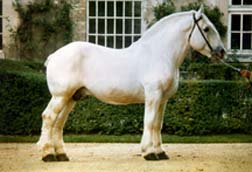Boulonnais
N/A
Fri, 4th April, 2025 - 4:09 pm GMT
Sponsor Ads:

Alternative Name
N/ABasic Info
The Boulonnais is a heavy horse with elegance and distinction. There are two types today: the small sized "fish cart horse," now very rare and the large Boulonnais. The "fish cart" type was mainly used in the seventeenth and eighteenth centuries to quickly transport freshly caught fish. This type stands between 15 to 15.3 hands and is light with great endurance. The large Boulonnais or "marée" type is a large, powerful horse often weighing over a ton. This type was developed in the nineteenth century to work in the beet fields. The Boulonnais is gray in color, ranging from a very light to a dark dappled shade. An occasional chestnut is seen in the breed. The head is elegant and short with a flat and wide forehead, very keen, proud eyes, well-opened nostrils and small mobile ears. The neck is thick and muscular; the mane is thick and short. The chest is wide with a well-rounded rib cage. The withers are well placed but often set deep in the musculature. The back is straight and the limbs are strong and solid with clean joints. There is very little hair on the legs.
Health
N/AHabitat
N/ABehavior
Energetic and lively, with a splendid gaitOrigin
BoulogneHistory
The Boulonnais is said to descend from the horses imported by Julius Caesar's legions, which stayed along the coasts of the Pas-de-Calais before invading what is now Great Britain. Much later came the Crusades and the Spanish occupation of Flanders. These events brought a great deal of Oriental and Andalusian blood to the Boulonnais area. Additional crosses with Andalusian stock and Mecklenburg blood from Germany further shaped the breed. The influence of these early ancestors sets the Boulonnais draft horse apart from other draft breeds. The Boulonnais' speed, elegant build, refined head, silky coat and thick mane can all be attributed to this hot-blooded ancestry. As far back as the seventeenth century, the Boulonnais horse has enjoyed a fine reputation with dealers from Picardie and Haute-Normandie coming to buy good animals for their business and use. The Boulonnais is probably best known for pulling fish delivery carts from Boulogne (the city from which it gets its name) to Paris. For this reason the breed earned the name "Mareyeur" which means "seller of fish" in French. Today, Boulonnais breeding animals are to be found in several northwest departments of France, notably Pas-de-Calais, North (Dunkerque and Hazebroucq), Somme, Seine-Maritime and Oise. They are primarily bred on government funded studs in order to prevent this impressive breed from dying out. Energetic and lively, with a splendid gait, the Boulonnais excels as a working draft horse and is much admired for its elegant teams in harness. The breed also has a reputation for improving other breeds of draft horse in spite of its very reduced numbersCommon Foods
grassSponsor Ads:
"Hence the enlightened ruler is heedful, and the good general full of caution. This is the way to keep a country at peace and an army intact." -- Sun Tzu, The Art of War
Boulonnais
Coded by: BGID® | ALL RIGHTS RESERVED Copyright © 2000-2025
Disclaimer | Privacy | Report Errors / Contact | Credits








 Preparing For China. China is growing their military. China Military Technology - can it keep up with the US?
Preparing For China. China is growing their military. China Military Technology - can it keep up with the US?  versus
versus 

 versus
versus 
 This Thread is about the North Korean Military itself - the kind of army, navy, and air force they have.
This Thread is about the North Korean Military itself - the kind of army, navy, and air force they have. 
 versus
versus 
 versus
versus  versus
versus